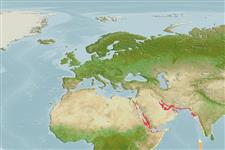>
Blenniiformes (Blennies) >
Tripterygiidae (Triplefin blennies) > Tripterygiinae
Etymology: Enneapterygius: Greek, ennea = nine times + Greek, pterygion = little fin (Ref. 45335).
Eponymy: Prince Alexander (also Iskinder and Eskander) Desta (1934–1974) was Admiral of the former Ethiopian Imperial Navy; he was one of 60 imperial officials who were executed when the Derg took over the country (where this blenny occurs in the Red Sea). (Ref. 128868), visit book page.
Environment: milieu / climate zone / profondeur / distribution range
Écologie
marin démersal; profondeur 2 - 12 m (Ref. 88983). Tropical
Western Indian Ocean: Red Sea.
Taille / Poids / Âge
Maturité: Lm ? range ? - ? cm
Max length : 2.1 cm SL mâle / non sexé; (Ref. 88983)
Description synthétique
Clés d'identification | Morphologie | Morphométrie
Épines dorsales (Total) : 14 - 17; Rayons mous dorsaux (Total) : 8 - 9; Épines anales: 1; Rayons mous anaux: 15 - 17; Vertèbres: 32 - 33. Diagnosis: Dorsal fins III + XI-XIII + 8-9 (usually III + XI-XII +8- 9); anal fin I, 15-17 (usually 16); pectoral fin 15: 3+5+7. LL, pored scales8-12; notched scales 21-23, starting at 2 scale rows below the end of the pored series; total lateral scales 28-29; transverse scales 2/5; nape with scales, abdomen scaleless, single row of scales at base of pectoral fin. Body depth 4.5-5.2 in SL. Vertebrae 10 + 21-22. Dentary pores 3 + 2 + 3; head 3.1-3.4 in SL; eye 2.5-3.0 in head length; orbital cirrus minute, rounded flap about half the diameter of pupil, distally serrated margin; supratemporal sensory canal crescent-shaped; first dorsal fin same height in males and females, about 60% of the second. Key features are: body bars brown; caudal peduncle spots 2 black, the lower one smaller; five black blotches on anal fin, anteriormost largest and darkest; face pink with brown bar below eye; first dorsal fin crimson in males (Ref. 57774, 88983).
Body shape (shape guide): fusiform / normal.
Adults inhabit bays and lagoons rich in corals, 2-12 m; usually found in crevices near Porites or on the vertical face of this coral (Ref. 88983). Eggs are hemispherical and covered with numerous sticky threads that anchor them in the algae on the nesting sites (Ref. 240). Larvae are planktonic which occur primarily in shallow, nearshore waters (Ref. 94114).
Life cycle and mating behavior
Maturité | Reproduction | Frai | Œufs | Fécondité | Larves
Holleman, W. and S.V. Bogorodsky, 2012. A review of the blennioid fish family Tripterygiidae (Perciformes) in the Red Sea, with description of Enneapterygius qirmiz, and reinstatement of Enneapterygius altipinnis Clark, 1980. Zootaxa 3152:36-60. (Ref. 88983)
Statut dans la liste rouge de l'IUCN (Ref. 130435: Version 2025-1)
Menace pour l'homme
Harmless
Utilisations par l'homme
Pêcheries: sans intérêt
Outils
Articles particuliers
Télécharger en XML
Sources Internet
Estimates based on models
Preferred temperature (Réf.
123201): 24.8 - 29.3, mean 28.2 °C (based on 202 cells).
Phylogenetic diversity index (Réf.
82804): PD
50 = 0.5000 [Uniqueness, from 0.5 = low to 2.0 = high].
Bayesian length-weight: a=0.00794 (0.00346 - 0.01822), b=3.08 (2.88 - 3.28), in cm total length, based on LWR estimates for this (Sub)family-body shape (Ref.
93245).
Niveau trophique (Réf.
69278): 3.0 ±0.3 se; based on size and trophs of closest relatives
Résilience (Réf.
120179): Haut, temps minimum de doublement de population inférieur à 15 mois (Preliminary K or Fecundity.).
Fishing Vulnerability (Ref.
59153): Low vulnerability (10 of 100).
🛈
